Origin Genesis Review: Triple Titan Terror
by Ryan Smith on April 23, 2013 9:00 AM ESTLetting Titan Spread Its Wings, Cont
Moving on, let’s take a look at 3 of our most intensive games: Battlefield 3, Far Cry 3, and Crysis 3.

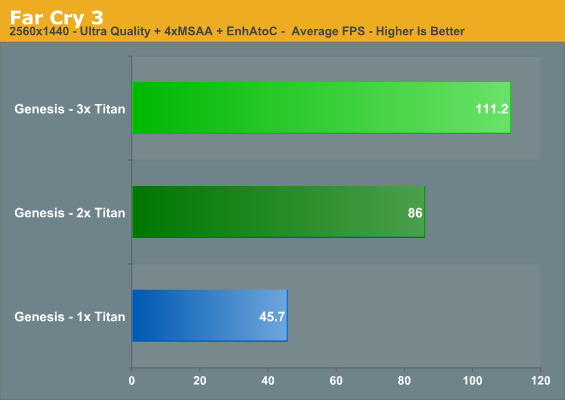
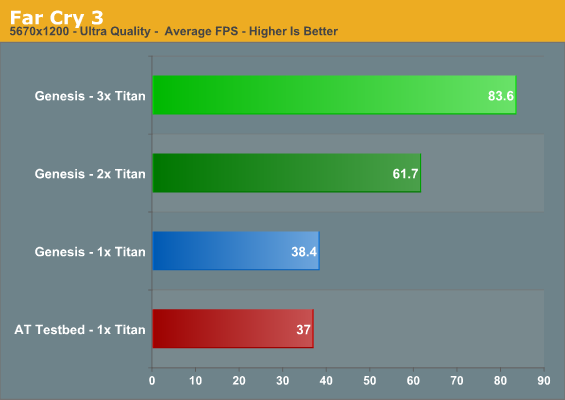
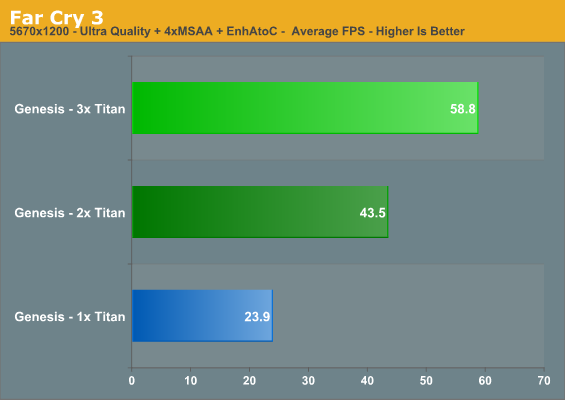
Far Cry 3 is another game that highlights the difficulty in keeping all 3 Titans fed. We have to go to 5760 before a tri-SLI setup isn’t being held back by the CPU. Once we’re there however, additional Titans make a clear difference. At least 2 are required to keep average framerates above 60fps at 5760 without anti-aliasing, and with the AA cranked up even 3 Titans can’t quite crack 60fps. This may be for the best though; for some reason the input lag at 5760 with 3 Titans is especially bad, and this is likely a further artifact of Far Cry 3’s quirks.
At the very least scaling is once again fairly good. At 5760 with AA moving from 1 to 2 Titans improves performance by 82%, and 2 to 3 Titans by another 35%.
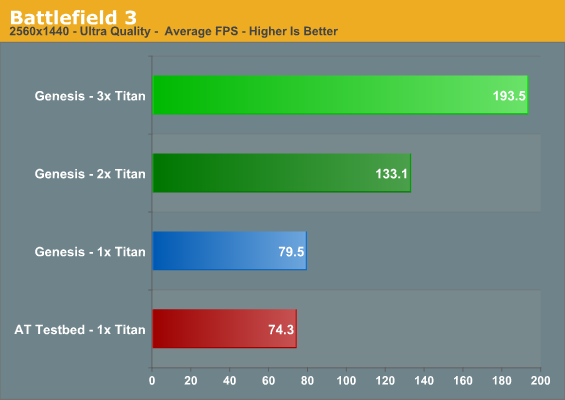
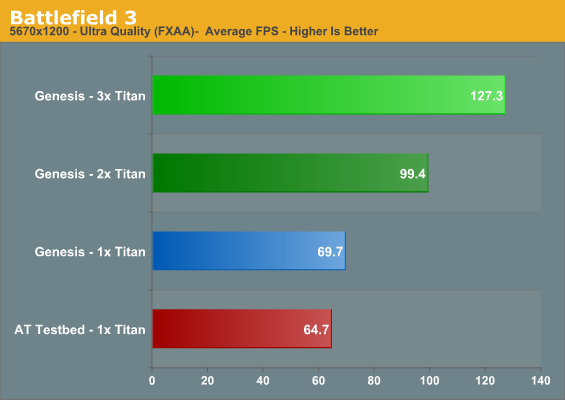
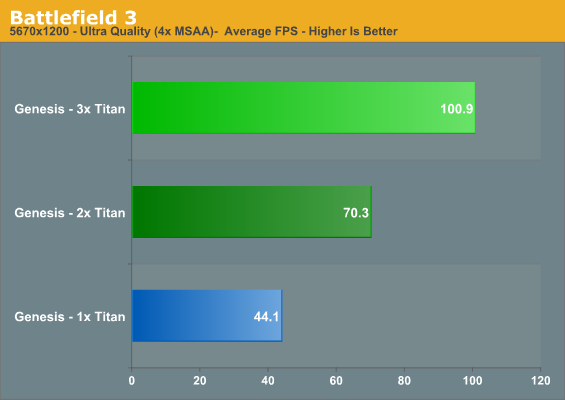
Battlefield 3 isn’t appreciable CPU limited, but it does present something of a scaling issue for Titan. Scaling with 1 display is only 67% for the 2nd Titan, and 45% for the 3rd. And with multiple displays at 5760 with MSAA that becomes 59% and 43% respectively. Oddities aside of scaling being relatively better with the 3rd Titan than the 2nd, even with MSAA we’re seeing an average of 70fps with 2 Titans at 5760, so minimum framerates are still above 30fps. So the practical advantage of the 3rd Titan is limited to minimum framerates, or otherwise doing 120Hz gaming.
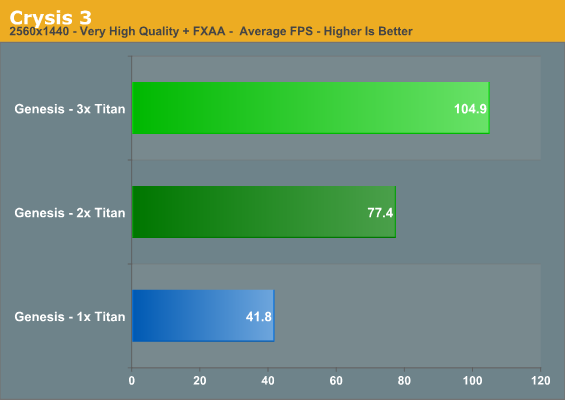
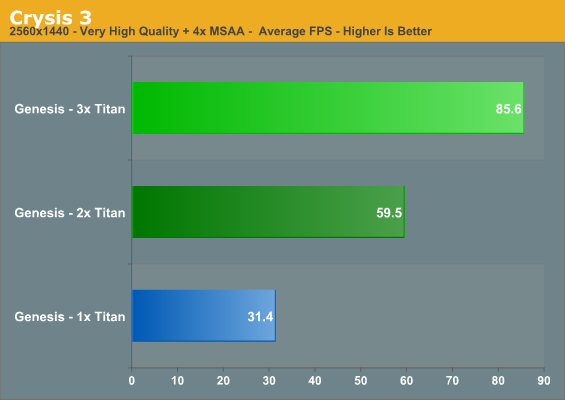
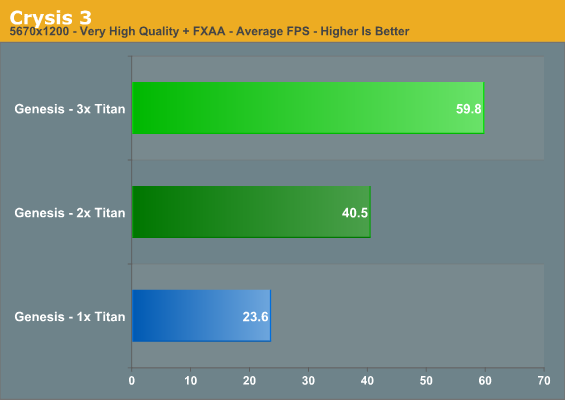
Finally we have Crysis 3, which is first being used here before rolling it into our larger benchmark suite. Taken from the intro level (Post-Human), Crysis 3 was meant to kill GPUs and it shows. 1 Titan can’t break 60fps at 2560 even with FXAA, and 2 Titans are just short if we add MSAA. Move to 5760, and even 3 Titans won’t break 60fps with FXAA. So while the rest of the games in our suite need multi-monitor resolutions to really take advantage of a tri-SLI setup, even 1 2560 monitor can drag a tri-SLI setup back down to earth when it comes to Crysis 3. Even if it’s not game of the year, just as in past years Crysis 3 will move high-end video cards; of that there’s no doubt.
Looking at Titan scaling again, Crytek and NVIDIA have clearly done their homework for single-monitor resolutions. At 2560 with MSAA scaling is 89% from 1 card to 2, and 44% from 2 cards to 3. Unsurprisingly, scaling does taper off at 5760 due to the performance hit of keeping multiple display buffers across multiple cards organized. 1 card to 2 cards is just 72% here, but adding a 3rd card adds another 47% in performance.
Across our 6 games we can see that 3 Titans generally pays off, but a big part of this is using resolutions and settings that can shift as much of the burden onto the GPU as possible. With the exception of Crysis 3 almost everything plays fine on just 2 Titans, with the 3rd Titan necessary to hit 5760x1200 with the best quality settings. On the other hand the fact that even Crysis 3 is almost at 60fps at 5760 with everything short of MSAA turned up is quite a change of pace. NVIDIA told us they wanted tri-SLI Titan to be a no-compromise gaming setup, and indeed they’ve delivered on that.
The only way we’d be able to push a tri-SLI Titan setup harder would either be to use a 2560x1440 surround setup – which admittedly isn’t outside the realm of possibility when we’re talking about pairing it with a $9000 computer – or otherwise going outside the lines and using SSAA on the titles that support it. It may come off as hyperbole, but “I have 3 monitors and the Genesis still isn’t slow enough” was a very real problem putting this article together. To that end it’s surprising that we weren’t CPU limited more often than we were; it’s still a concern, but for the most part in surround gaming the CPU can stay ahead of the GPU, at least if it’s as heavily overclocked as the Genesis’ 4.9GHz SNB-E.










63 Comments
View All Comments
shadowofthesun - Tuesday, April 23, 2013 - link
Gotta agree with this- I ended up ditching my HDMI via nVidia setup because it worked extremely poorly in Linux and even in Windows would fail to initialize my HDMI output as an audio device if the screen went to sleep. Luckily the optical out works fine.viliu - Tuesday, April 30, 2013 - link
meh, the same as a Ferrari, it's obviously quick, but noisy, hot and draws a hell of a lot of fuel.But i'l bet ur lick ur back side for one of those... Anyway, there are always beautiful things for car/boats/computers and whatever enthusiasts .I will definitely want one of those, even if i already have a nice car and a good computer, but as human i will always want more and never will be happy whit whatever i have nowwingless - Tuesday, April 23, 2013 - link
Can I finally play a game with triple monitors in 3D on this machine? Barely; Still this is an amazing machine, especially for those in cold climates. I like it!APassingMe - Tuesday, April 23, 2013 - link
Thanks for the great review, it reminds me of all the reasons why I still read AnandTech after all these years.However, could you please run your reviews through a good third party for a quality check? It really is distracting to read through the review and have to pause and think.... what's missing here... Oh, it's just that "of" is left off or something similar, I know it slows down the overall release of the review but please consider it.
Thanks.
-APassingMe
geniekid - Tuesday, April 23, 2013 - link
I feel like the whole point of liquid cooling is to shunt heat to a radiator which is then cooled by a low flow fan. Why then do you need 13 million (possible exaggeration) case fans?A5 - Tuesday, April 23, 2013 - link
There are two reasons to watercool:1) Reduce noise and maximize cooling on modest machines
2) Maximize cooling to reach insane performance heights.
This system is firmly in the second camp. It simply wouldn't be possible to run it at these clocks on air cooling.
A5 - Tuesday, April 23, 2013 - link
Also, in this case, each case fan slot is actually a radiator with 2+ fans on it.DanNeely - Tuesday, April 23, 2013 - link
If it was a more modest setup you wouldn't; but this system has a heavy overclocked CPU and 4 heavily overclocked GPUs; which means it's trying to dump close to 1200W through the radiators. In a more mainstream system you'd have ~80-150W from the CPU and 150-300W from the GPU. In that case a single 3x120 rad with one set of fans (vs push pull) would probably be adequate, and be much quieter under load than the GPUs blower.justaviking - Tuesday, April 23, 2013 - link
Compute performance? I was curious what sort of compute performance you'd get with 3 Titans. Did I just miss that? Of course, it doesn't really matter. I did not find $9k in my pocket this morning. But it would still be interesting to see.colinstu - Tuesday, April 23, 2013 - link
Hope 6-8 years from now this same amount of power can be had in the space of a small matx case and for $600-1200. But then again... just imagine how the games will be (or won't be) by then.